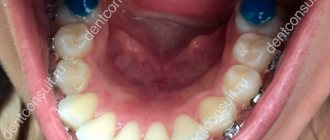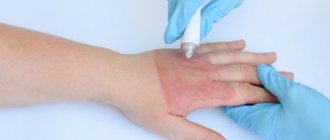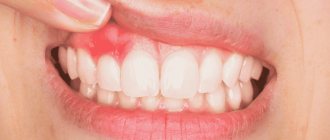26.11.2019
Today, there are often situations when, after dental treatment, a filling interferes with the patient. Although during the process of filling and correction the dentist carries out all the necessary manipulations so that the material does not seem like a foreign body, it is not always possible to do everything perfectly. The problem is fraught with impaired chewing function and improper closing of the jaws. You should study in detail the symptoms and causes of this phenomenon, and also figure out how the patient should behave in such cases.
Symptoms of an incorrectly placed filling
Very often, patient complaints about discomfort after installing a filling have nothing to do with improper manipulation or excess materials. This often happens when most of the tooth has been destroyed and the patient has become accustomed to the emptiness. Consequently, after filling, a false feeling of discomfort appears, which is caused by an unusual feeling of fullness in a place that has been empty for a long time. In such situations, you need to wait a little - often within a few days a person gets used to the new sensations, and the installed filling ceases to cause discomfort.
First of all, you need to figure out how to understand whether the discomfort is associated with the adaptation period, or whether the unpleasant sensations are a consequence of the doctor’s incorrect actions.
There are several symptoms indicating improper installation of filling material:
- On the side of the tongue, in the place where the product is installed, pain is felt or there is a wound.
- During chewing, discomfort is replaced by a feeling of pressure or pain.
- After a visit to the doctor, the patient experiences articulation disorders - slurred pronunciation of sounds.
- When you try to compress your jaws, the presence of foreign material prevents you from doing so.
If at least one of the above-described signs appears, we can say that the structure requires additional polishing.
Types of overbite fillings
Two types of structures are most widely used in orthodontics:
- Katz model. The filling is held on the chewing teeth using loops and grips.
- Model of Khurgina. The design has a rubber traction.
The materials from which the platforms are made must be reliable, since the product is subjected to significant loads. Most often used:
- artificial dentin;
- dentin paste;
- cement;
- polymers.
Many orthodontists prefer the latter option. When dental polymers harden, they do not turn into stone, but acquire a fairly elastic consistency, similar to rubber. Polymer fillings adhere well to enamel and do not require additional processing.
Causes
The main reason for the appearance of the symptoms described above is an excess of filling materials and inaccurate formation of the surface of the restored unit. Because of this, the surface of the tooth becomes slightly higher than necessary for proper closure of the jaws.
The qualifications of the specialist who performed the filling procedure are not always the cause of the problem. Often, local anesthesia is used during the installation of fillings, so the patient may not accurately describe his sensations when the specialist asks him to describe the sensations after the final polishing is completed. As a result, after the medication wears off, discomfort appears that was absent when you were in the dentist’s chair.
In some cases, the source of discomfort may be the inflammatory process of the periodontium, due to a violation of the stable position of the dental unit. Almost imperceptible tooth mobility can disable the mechanism of closure of the upper and lower jaw. But before the filling was carried out, the missing part of the unit compensated for the defect. Accordingly, after complete restoration of the size and shape of the tooth, the disease manifests itself in full.
Another cause of discomfort can be tooth misalignment. Often this symptom appears after filling a gap between teeth or removing a unit in the same row. Complaints that the filling is in the way appear several months after installation. The missing unit causes the remaining teeth to shift towards the empty space, so when they are closed tightly, unpleasant sensations appear.
A common cause can also be an excessively thin wall between the pulp chamber and the product. Because of this, the pressure that is applied to the filling during chewing is transferred to the bottom of the chamber and irritates the dental nerve. In such cases, the cause of the unpleasant sensations lies inside the dental unit, but is felt as a structural defect.
Should I go to the dentist?
Order in the oral cavity, the absence of diseases and problems is the key to the success of a healthy body. Timely treatment of caries plays a paramount role in this. Darkening of the enamel layer leads to its damage. Dentin also suffers from this. Subsequently, without proper therapy, hard tissues soften, demineralization occurs, and abnormal holes appear. Bacteria provoke this disease, and pathological areas begin to hurt. Treatment for moderate caries takes one visit. Deeper lesions require 2-3 visits.
If a filling interferes with your bite, you should definitely contact a dentist. After all, filling should not harm the patient. The bite should remain correct, the jaws should close normally. When problems arise, the dentist:
- grinds the protruding surface of the cement;
- if the overlay is still in the way, it is adjusted;
- when the optimal position is reached, the insert is polished;
Patients feel even one millimeter of excess glue like a foreign body in the mouth. This is where the discomfort comes from. You should make an appointment with a doctor if you notice a sharp edge that injures the soft tissues of the oral cavity, in particular the gums, cheeks, and tongue. This means that the filling material is not polished enough, there is a gap, a crack, or a step between the crown and the cement. In such a situation, there is a risk of accumulation of microbes and plaque in the rough zone. Over time, a carious lesion will form in this area. To prevent this from happening, the dentist will prevent anomalies and serious negative consequences.
Norm or pathology
Let's consider the options for normal and pathological conditions, in which you should immediately consult a dentist.
Is it worth going to the doctor?
It is unlikely that you will be able to correct the situation on your own without qualified help. Therefore, if the filling interferes, you need to contact your dentist.
Many people, when faced with such a problem, try not to pay attention and wait for the material to erase itself. This opinion is erroneous, since modern dental preparations used for filling have high strength values. Therefore, it can take years for abrasion to occur.
The opinion regarding shrinkage over time is correct, but until this happens, a significant period of time may pass. It is impossible to get used to unpleasant symptoms, and keeping the jaw in this state for a long time can lead to negative consequences.
What happens if you ignore a filling?
Some patients do not pay attention to the problem for a long time. This is wrong, as serious complications may arise. If an oversized filling interferes a little, a high load falls on this unit.
- This leads to chronic crown injury.
- Constant high blood pressure causes periodontitis, pulpitis, and there is a risk of chipping the wall of the masticatory organ.
- A one-sided misalignment occurs, the jaw moves to the side.
- It will take some time and the body will get used to it, but the problem will not go away.
- Unusual jaw position often causes diseases of the temporomandibular joints.
Therefore, therapy should begin as soon as discomfort appears. The lower and upper units must be in good contact. This is the only way to ensure complete chewing of food. In this regard, the applied cement should be at an optimal comfortable height. When problems arise, restoration of chewing teeth is carried out. The dentist checks all closure points using a carbon copy, ascertains the patient’s subjective sensations, and makes adjustments.
Home treatment methods
As mentioned above, it is impossible to get rid of the problem at home, and it is unreasonable to expect natural abrasion of the material.
To alleviate the condition before visiting a specialist, you need to follow certain recommendations:
- Avoid eating hard foods that require biting. The sealed unit, due to its higher location, is subject to the main load, and this is fraught with a fracture of its base.
- Eliminate hot foods from your diet. This is because such foods and drinks can cause swelling of the soft tissues, increasing the discomfort.
- For severe pain, analgesics or non-steroidal anti-inflammatory drugs can be used. However, you should not abuse such drugs, because their use is limited - no more than 5 days.
How does tooth filling occur?
The choice of material for closing a carious cavity depends on the individual characteristics of the patient and other factors. In modern dentistry, photocomposites are most often used. Reflective materials are reliable, have a long service life and allow you to completely restore a tooth damaged by caries.
At the initial stage of treatment, the doctor cleans the cavity of dead tissue and bacteria. Then the working area is treated with a special solution. To avoid moisture ingress, the tooth to be restored is isolated with a latex scarf. If this process is disrupted, the integrity of the restoration will suffer and the filling will be installed poorly. Over time, this can lead to recurrent tooth decay.
After processing, a bond is fixed to create an adhesive layer that increases the reliability of fixation of the material on the tooth tissue. A flowable composite is then applied to the cavity walls and hardened using a curing lamp. The material is applied in layers. Each portion is exposed to a lamp.
At the last stage of treatment, the final fitting, grinding and polishing of the filling takes place. This is necessary to give the original shape and form the correct bite.
What will the dentist do?
First of all, the doctor will perform repeated manipulations to process the product using a copy napkin. After applying it to the tooth, the patient will need to clench his jaw tightly. The interfering area is determined by the imprints left on the surface of the unit.
If the cause of the pain is periodontal disease, a periodontist is involved in the treatment process, who, together with the therapist, works to eliminate the problem.
In some cases, removal of the filling may be indicated. After preparing the dental unit, medicinal substances are placed in it, as well as an insulating lining. Then a temporary filling is installed and the patient is sent home. If after a second visit the dentist notices an improvement, a permanent product is installed.
Rules of care
Removable pads must be stored in a special solution and washed in water before putting them on. A disinfectant solution is necessary in order to reduce the number of microorganisms on the surface of the structure and avoid the appearance of bad breath. The fixed platform must be cleaned of plaque twice a day with a special paste and a soft-bristled brush. When playing sports, it is better to leave removable structures in the locker room.
Possible consequences
If the installed filling material interferes with the full closing of the mouth and jaw closure, this is fraught with side effects for the patient.
The consequences may be as follows:
- Pressure on antagonist teeth. If the product is not installed correctly, the adjacent teeth will exert constant pressure on the filled unit. It can provoke periodontal trauma and the development of secondary caries.
- Formation of cracks and chips on the surface. Excessive pressure can not only cause injury, but also lead to chipping. In addition, weak tooth walls can break off along with the filling.
- Dislocation of the jaw. Incorrectly installed elements can cause insufficient jaw closure. Misalignment of one part in relation to the other will lead to dislocation.
How to maintain your treatment guarantee
To maintain the guarantee, the patient must strictly follow all recommendations: do not overload the tooth, do not use it for other purposes (for example, opening beer bottles, biting off threads), and also regularly see the doctor in accordance with the individual schedule of medical examinations, approximately once every six months. Unfortunately, many patients forget about this, and it is the last point that is the key to maintaining the guarantee for treatment.
You need to visit a doctor 1-2 times a year. During a preventive examination, the dentist will be able to make sure that the filling is in good condition, and that secondary caries does not develop again under it.
Expert advice
The arrangement of teeth in a row was initially determined by nature, so the elements must touch correctly for the full implementation of the chewing function. A change in the bite can cause an incorrect distance between the jaws. Once such a pathology develops, it will be much more difficult for the doctor to eliminate it.
To minimize the likelihood of complications, the patient must take certain actions himself. If bite defects are observed within a few days after installing the composition, you should immediately consult a dentist. Correcting the filling will take a few minutes, but these manipulations will help prevent the development of disorders.
After installing the material, some people complain about roughness and stepped placement of the composition. Pathogenic microorganisms can accumulate in the formed cavities, which will lead to the development of secondary caries. In such cases, it is also necessary to urgently visit the dentist's office.
Category Dental filling Posted by Mister stomatolog
Content
- Causes of destruction
- Activities before treatment with a doctor
- Temporary filling fell out
- A permanent filling fell out
- Price
- Prevention of destruction
No one is safe from falling out or partial chipping of a filling. The patient experiences discomfort. This is both a moral component and very real inconvenience. The problem becomes the inability to chew food normally, excessive tooth sensitivity, even pain. You need to contact a specialist immediately to stop tooth decay and restore its normal functions.
PROMOTION
Dental restoration, installation of fillings
from 2200 rub.
How long can a filling last?
The service life depends on the selected dental treatment material. The photopolymer composite is well fixed and wears minimally. If all rules are followed during the filling stages, as well as proper oral hygiene, fillings will last about 10 years or longer. Please note that the operation of any material is poorly affected by mechanical loads. For example, it is strictly not recommended to open lids with your teeth or chew nuts or seeds.
Attention. Proper hygiene includes not only home care, but also regular professional cleaning. The dentist will select the procedure method taking into account the individual needs and characteristics of the patient.










